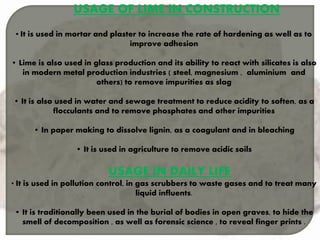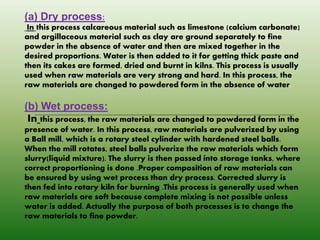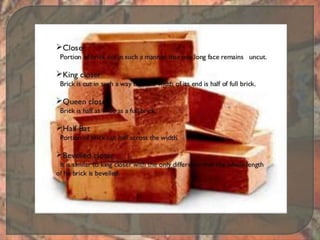3. lime , cement , sand , brick
- 3. LIMESTONE Limestone is sedimentary rock composed principally of Calcium Carbonate (Calcite) or the double carbonate of Calcium and Magnesium (Dolomite). It is commonly composed of tiny fossils, shell fragments, and other fossilized debris. Some limestone’s have an extremely fine grain. Limestone is usually Grey, but it may also be White, Yellow, or Brown. It is a soft rock and is easily starched. It will effervesce readily in any common acid. USAGE IN BUILDING Depending on the quality of deposit, limestone can be quarried to service the needs of the building and construction industries. It is used as a building stone. In road construction, limestone aggregate direct from the quarry can be used as a base material. Lower-grade limestone can be used in the production of cement, which is a key ingredient of concrete
- 4. TYPES OF LIMESTONE Coquina: Limestone that contains large pieces of shells or coral Chalk: Limestone that is formed from microscopic marine organisms Travertine (Limestone formed around a spring or a waterfall ) Oolite: Limestone that is formed around high- temperature areas such as tropical seas or lagoons
- 5. USAGE OF LIME IN CONSTRUCTION • It is used in mortar and plaster to increase the rate of hardening as well as to improve adhesion • Lime is also used in glass production and its ability to react with silicates is also in modern metal production industries ( steel, magnesium , aluminium and others) to remove impurities as slag • It is also used in water and sewage treatment to reduce acidity to soften, as a flocculants and to remove phosphates and other impurities • In paper making to dissolve lignin, as a coagulant and in bleaching • It is used in agriculture to remove acidic soils USAGE IN DAILY LIFE • It is used in pollution control, in gas scrubbers to waste gases and to treat many liquid influents. • It is traditionally been used in the burial of bodies in open graves, to hide the smell of decomposition , as well as forensic science , to reveal finger prints .
- 7. ADVANTAGES & DISADVANTAGES OF LIMESTONE • COMPLEMENTARY : Whether you are using Limestone as trim with brick or other materials, or to maintain the context of the surrounding area, its natural beauty will enhance your project. •CONSISTENCY : One benefit that has made Indiana Limestone the product of choice is the consistency of deposit. While subtle color and grain differences are present, Limestone is extremely homogenous for a natural product. This is important, not only for the current project being built, but particularly when future expansions are contemplated. • COST EFFECTIVE : Proven durability and the fact that it's virtually maintenance free, makes Indiana Limestone extremely cost effective to use. The Indiana Limestone Institute can provide additional advice to show you the many economical ways to use Indiana Limestone and bring your project in on time and within budget.
- 9. CEMENT: •Cement is the mixture of calcareous, siliceous, argillaceous and other substances. Cement is used as a binding material in mortar, concrete, etc. • Chemical Composition of cement : Lime 63% Silica 22% Alumina 06% Iron oxide 03% Gypsum 01 to 04% • Manufacturing of cement: (1) Mixing and crushing of raw materials . A . Dry process B. Wet process (2) Burning (3) Grinding
- 10. (a) Dry process: In this process calcareous material such as limestone (calcium carbonate) and argillaceous material such as clay are ground separately to fine powder in the absence of water and then are mixed together in the desired proportions. Water is then added to it for getting thick paste and then its cakes are formed, dried and burnt in kilns. This process is usually used when raw materials are very strong and hard. In this process, the raw materials are changed to powdered form in the absence of water. (b) Wet process: In this process, the raw materials are changed to powdered form in the presence of water. In this process, raw materials are pulverized by using a Ball mill, which is a rotary steel cylinder with hardened steel balls. When the mill rotates, steel balls pulverize the raw materials which form slurry(liquid mixture). The slurry is then passed into storage tanks, where correct proportioning is done .Proper composition of raw materials can be ensured by using wet process than dry process. Corrected slurry is then fed into rotary kiln for burning .This process is generally used when raw materials are soft because complete mixing is not possible unless water is added. Actually the purpose of both processes is to change the raw materials to fine powder.
- 11. 2) Burning: Corrected slurry is feed to rotary kiln, which is a 150-500 feet long, 8-16 feet in diameter and temperature arrangement is up to 1500-1650 degree C. At this temperature slurry losses moisture and forms into small lumps ,after that changes to clinkers. Clinkers are cooled in another inclined tube similar to kiln but of lesser length. 3) Grinding: Now the final process is applied which is grinding of clinker, it is first cooled down to atmospheric temperature. Grinding of clinker is done in large tube mills. After proper grinding gypsum (Calcium sulphate Ca SO4)in the ratio of 01-04 % is added for controlling the setting time of cement .Finally, fine ground cement is stored in storage tanks from where it is drawn for packing.
- 12. CHARACTERISTICS •It possesses high strength that’s why it is used in majority of buildings, bridges, tunnels, etc. •It is highly durable and not affected by moisture, mold or pests. •As compare to other building materials it is highly affordable. •It is fire-resistant and a highly effective barrier to fire spread. •It slows the passage of heat moving in the structures and reduces its temperature. TYPES OF CEMENT There are many types of cement used for different purposes but the main classification is composed of two types 1. Ordinary Portland Cement (OPC) 2. 3. Sulfate Resisting Cement (SRC)
- 13. •ORDINARY PORTLAND CEMENT (OPC): It is the most common type of cement in general use around the world. It is the variety of artificial cement. It is called Portland cement because on hardening (setting) its color resembles to rock near Portland, England. It is consists of Lime, Silica, Alumina, Gypsum, and some auxiliary constituents. It is used in general construction works like in walls and plastering. All other varieties of cement are derived from this cement. It has two types: White Cement, and Colored Cement. •SULFATE RESISTING CEMENT (SRC): •It is theoretically ideal cement which is prepared by maintaining the percentage of tri-calcium aluminate below 6% which increases power against sulfates. It is costly because of stringent composition requirements. It is used in construction exposed to severe sulfate action by water and soil in places like Canals, Linings, Culverts, Retaining Walls, Siphons, etc. it is also use in underground and basement structures, piles, foundations, water and sewage treatment plants etc.
- 14. 3- Sand
- 15. SAND Sand is naturally occurring granular material composed of finely divided rocks and mineral particles. It is defined by size, being finer than gravel and coarser than silt. Sand can also refer to a textural class of soil or soil type, i.e. a soil containing more than 85% of small-sized particles. Sand is an extremely needful material for the construction. But this most important material must be purchased with all care and vigilance. Sand which is used as a construction material must be clean, free from stones, waste, and impurities. CLASSIFICATION Sand is classified into three categories: River Sand Pit Sand Hill Sand
- 16. RIVER SAND: The river sand is procured from river streams and banks. It is fine in quality unlike pit sand. This type of sand has rounded grains generally in white- grey color. River sand has many uses in the construction purpose such as plastering. PIT SAND: It is also known as coarse sand. This type of sand is procured from deep pits of abundant supply and it is generally in Red-Orange color. The course grain is sharp, angular, and certainly free from Salts etc. It is mostly supplied in Concreting. Hill Sand: Hill sand is found in mountainous regions. It is formed by decomposition of organic matter from forests. It is rich in humus and poor in potash and lime.
- 17. PROPERTIES OF GOOD SAND •It should be clean and coarse. •It should be free from any organic or vegetable matter; usually 3-4 per cent clay is permitted • It should be chemically inert. • It should contain sharp, angular, coarse and durable grains. It should not contain salts which attract moisture from the atmosphere. • It should be well graded, i.e., it should contain particles of various sizes in suitable proportions . •It should be strong and durable. • It should be clean and free from coatings of clay and silt.
- 18. 4- Brick
- 19. Brick Bricks are one of the oldest building material back to 7000BC. Brick is a basic building unit which is in the form of rectangular block in which length to breadth ratio is 2 but height can be different. The standard size of brick is 9x 4 x 3 . A brick is regular in shape and of size that can be conveniently handled with one hand. Bricks may be made from the mixture of burnt clay, mixture of sand and lime, fly-ash lime and sand, and Portland cement concrete. Clay bricks are commonly used since they are economical and easily available. .
- 20. CLASSIFICATION •FIRST CLASS BRICKS (A-TYPE) These are thoroughly burnt bricks and are of deep red, cherry, or copper color. The surface of these bricks is smooth and rectangular, with sharp and straight edges and square corners. A metallic or ringing sound comes when two bricks are struck against each other. Their water absorption power is about 12%-15% of its dry weight. It is used for pointing, exposed face work in masonry structures, flooring and reinforcement brick work. •SECOND CLASS BRICKS (B-TYPE): They are supposed to have some requirements as the first class except that there may be some small cracks and distortions, or they have more absorption power of about 16%-20%. They are used in important or unimportant hidden masonry works, and centering of reinforced brick structures. •THIRD CLASS BRICKS (C-TYPE): Third class bricks are under-burnt bricks. They are soft and light colored producing a dull sound when struck against each other. Their water absorption power is about 25% of dry weight. They are used in building temporary structures. •FOURTH CLASS BRICKS (D-TYPE): Fourth class bricks are over-burnt and badly distorted in shape and size and are brittle in nature. They are used in filling of foundation and floors.
- 22. . PROPERTIES OF BRICKS • Aesthetic Bricks offer natural and a variety of colors, including various textures •Strength Bricks offer excellent high compressive strength. •Porosity The porosity of bricks in attributed to its fine capillaries. The ability to release and absorb moisture is one of the most important and useful properties of bricks, regulating temperatures and humidity inside structures. •Fire Resistance When prepared properly a brick structure can give a fire protection maximum rating of 6 hours • Sound Insulation The brick sound insulation is normally 45 decibels for a 4.5 inches brick thickness and 50 decibels for a nine inch thick brick. •Insulation Bricks can exhibit above normal thermal insulation when compared to other building materials. Bricks can help regulate and maintain constant interior temperatures of a structure due to their ability to absorb and slowly release heat. This way bricks can produce significant energy savings, more than 30% of energy saving, when compared to wood.
- 25. THE END
























